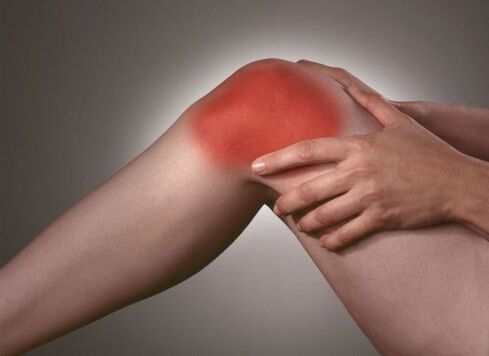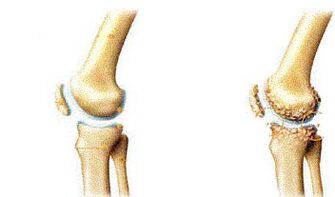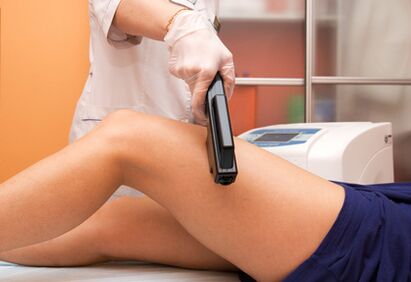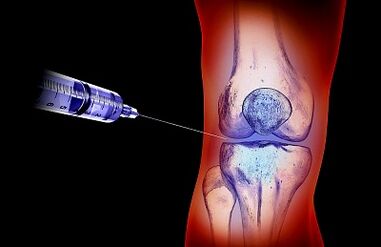
Like a person's other joints, the knee is composed of bones and cartilage.The cartoon is a smooth, elastic and elastic layer that ensures ease of gait and lack of friction.The damage to cartilage by chronic wear is calledKnee articulation.
There are many factors that cause knee arthritis:
- Genetic tendency;
- overweight;
- abnormal movement;
- Injuried.
For a long time, a person will not suffer pain, and the first symptom will occur only when the joints of the knee cause fatigue and deformation.The patient consults a doctor, but the treatment of advanced disease has been successful.
The articity of the knee joint is usually the result of accidents and injuries, but it will only be manifested after a few years.Therefore, in the case of suspicion of this disease, you should consult a doctor.
Knee joint symptoms
Symptoms of knee joints include:

- Increased pain during activity;
- swelling;
- Increase the temperature of the skin;
- The mobility of the knee joint is reduced;
- The squeaking, crisp sounds heard during exercise.
Pain after doing nothing is one of the most common symptoms of knee joints.She expressed herself in the morning when the joints needed time to warm up the right way.After about a person, the pain subsides.
Sometimes you can notice the first sign of the knee joint just by looking at him.Even if the knees are stretched out more than usual, this may be the first sign.The increase in knee swelling is easy to identify.The finger-thick bulges form above the knee cup because this place is the weakest.This is due to the increased accumulation of fluid in the joints.
Reducing leg flexibility may indicate knee joints.Those who once could touch the heels of the hips and stood on one leg but could walk halfway today should consult a doctor.The thigh muscles may be more difficult than before, and due to the knee joints, they become shorter and start to get injured.These muscles need to be stretched and strengthened to restore previous functions.
Another sign of knee joint joints is a decrease in muscle strength in the legs.
Arthritis turns into cartilage, which is smooth like glass, turns into a rough fabric that looks like sandpaper in the early stages.As these surfaces rub against each other, you hear squeaks and rubbing sounds in the joints.
How to diagnose arthritis in the knee joint?

The diagnosis of knee osteoarthritis will begin with a doctor's physical examination.Before taking it, determine what pain occurs to help your doctor make the correct diagnosis.Also, find out if your family has arthritis.
Your doctor may prescribe other diagnoses, including:
- Magnetic resonance imaging (MRI) scans X-rays, which can show bone and cartilage damage, as well as the presence of bone spurs;
- MRI can be ordered when X-rays do not have obvious causes of joint pain or when X-rays show that other types of joint tissue may be damaged.Doctors can use blood tests to rule out other conditions that may cause pain, such as rheumatoid arthritis, another type of arthritis caused by a damaged immune system.
How to treat knee joints?
The main task of treating knee osteoarthritis is to relieve pain and return to mobility.
Treatment plan, usually consisting of a combination of the following operations:
- lose weight.If necessary, even a small amount of weight can significantly reduce knee pain in osteoarthritis.
- exercise.Strengthen the muscles around the knees, make the joints more stable and relieve pain.Stretching helps keep your knees moving and flexible.
- Anesthesia and anti-inflammatory drugs:acetaminophen, ibuprofen or sodium.If the medication is not helpful, your doctor can give you a prescription for another anti-inflammatory drug to relieve pain.
- Injection of corticosteroids or hyaluronic acid in the knee.Steroids are powerful anti-inflammatory drugs.Hyaluronic acid is usually present in joints as a lubricant, but due to joint diseases, it lacks joint diseases.
- Alternative treatment.Some alternative treatments that can be effective include: capsaicin, acupuncture or additives, including glucosamine and chondroitin.
- Use devices like brackets.There are two types of brackets: unloading braces, thus reducing weight from the sides of the knee; and "support" brackets that provide support for the entire knee.
- Physical exercise and labor therapy. If you have problems with your daily activities, physical exercise or labor therapy may help.A physical therapist will teach you how to strengthen muscles and improve joint flexibility.Experts will write a set of exercises that are suitable for your performance at home to relieve pain.
- Surgery.When other treatments don’t work, surgery is the only option to get rid of the disease.

Is the surgery used to treat osteoarthritis in the knee?
In order to treat knee osteoarthritis with surgical intervention, the following options can be selected: arthroscopy, osteotomy, and internal main surgery.
existArthroscopySmall telescopes (arthroscopy) and other gadgets were used.The surgery is performed through a small incision.The surgeon uses an arthroscopy so that the joints can be seen.After the surgeon can remove cartilage or damaged free particles, he can clean the surface of the bone.This procedure is usually used in patients aged 55 (and below) to delay more severe surgery.
Osteotomy- This is a process of trying to align the knees and change the shape of the bones.This type of operation is recommended if damage is caused in one area of the knee first.It can also be recommended if your knee is damaged and has not recovered.Osteotomy has no constant effect and may require surgery in the future.
Opthetics- This is a surgical procedure in which the joint is replaced by an artificial part of metal or plastic.Replacement may include one side or full knee.Usually, people over 50 years of age and severe osteoarthritis need to be replaced.If the substitute gradually disappears after a few years, but with modern achievements, most prostheses have been serving for more than 20 years, it may be necessary to operate later.Operations are risky, but the results are usually very good.



















